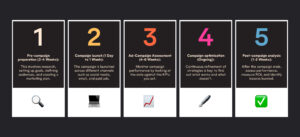A key way for marketers to stay on track of their different campaigns and activities is to create a marketing timeline.
It’s so easy to get lost in a sea of to-dos, and often, everything feels like a priority! This means when key dates arise, it can be a rush to get all of the content and assets needed to make it a success.
Take Christmas for example.
It seems to come round faster and faster each year, and if you don’t have a marketing timeline that states what your team needs to create and when, you can end up pushing something out for the sake of it.
You shouldn’t really be posting any content if you’re not 100% happy with it, but by creating a marketing timeline and giving yourself and your team visibility over key dates and seasons, you can stay ahead and make sure every campaign is properly considered.
In this blog, we’ll be delving deeper into how to create your own marketing timeline as well as showing you an example.










